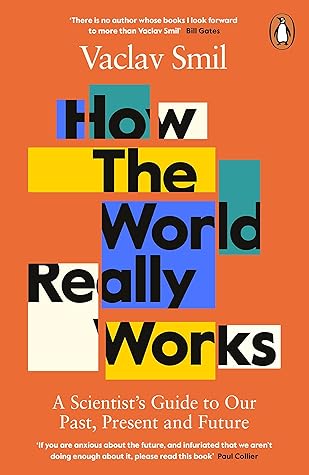More on this book
Community
Kindle Notes & Highlights
by
Vaclav Smil
Read between
October 6, 2022 - October 20, 2024
But by 2020 more than half of the world’s electricity will still be generated by the combustion of fossil fuels, mainly coal and natural gas.
An average inhabitant of the Earth nowadays has at their disposal nearly 700 times more useful energy than their ancestors had at the beginning of the 19th century.
Energy conversions are the very basis of life and evolution. Modern history can be seen as an unusually rapid sequence of transitions to new energy sources, and the modern world is the cumulative result of their conversions.
“the economic system is essentially a system for extracting, processing and transforming energy as resources into energy embodied in products and services.”23 Simply put, energy is the only truly universal currency, and nothing (from galactic rotations to ephemeral insect lives) can take place without its transformations.
large nuclear reactors are the most reliable producers of electricity: some of them now generate it 90–95 percent of the time, compared to about 45 percent for the best offshore wind turbines and 25 percent for photovoltaic cells in even the sunniest of climates—while Germany’s solar panels produce electricity only about 12 percent of the time.33
In two centuries, the human labor to produce a kilogram of American wheat was reduced from 10 minutes to less than two seconds.
Our best data are available for the US, where, thanks to the prevalence of modern techniques and widespread economies of scale, the direct energy use in food production is now on the order of 1 percent of the total national supply.47 But after adding the energy requirements of food processing and marketing, packaging, transportation, wholesale and retail services, household food storage and preparation, and away-from-home food and marketing services, the grand total in the US reached nearly 16 percent of the nation’s energy supply in 2007 and now it is approaching 20 percent.
Between 1800 and 2020, we reduced the labor needed to produce a kilogram of grain by more than 98 percent—and we reduced the share of the country’s population engaged in agriculture by the same large margin.50 This provides a useful guide to the profound economic transformations that would have to take place with any retreat of agricultural mechanization and reduction in the use of synthetic agrochemicals.
daily average per capita requirements of adults in largely sedentary affluent populations are no more than 2,000–2,100 kilocalories, far below the actual supplies of 3,200–4,000 kilocalories.63 According to the FAO, the world loses almost half of all root crops, fruits, and vegetables, about a third of all fish, 30 percent of cereals, and a fifth of all oilseeds, meat, and dairy products—or at least one-third of the overall food supply.64 And the UK’s Waste and Resources Action Programme ascertained that inedible household food waste (including fruit and vegetable peelings, and bones) is only
...more
industrial man no longer eats potatoes made from solar energy; now he eats potatoes partly made of oil.”
even if we try to change the global food system as fast as is realistically conceivable, we will be eating transformed fossil fuels, be it as loaves of bread or as fishes, for decades to come.
while there can be no indisputable ordering of our material needs based on claims of their importance, I can offer a defensible ranking that considers their indispensability, ubiquity, and the demand size. Four materials rank highest on this combined scale, and they form what I have called the four pillars of modern civilization: cement, steel, plastics, and ammonia.
the first airline company, the Dutch KLM, was set up in 1921.
only about 18 percent of the global goods trade is now driven by lower labor costs (labor arbitrage), that in many chains this share has been declining throughout the 2010s, and that global value chains are becoming more knowledge-intensive and rely increasingly on highly skilled labor.


